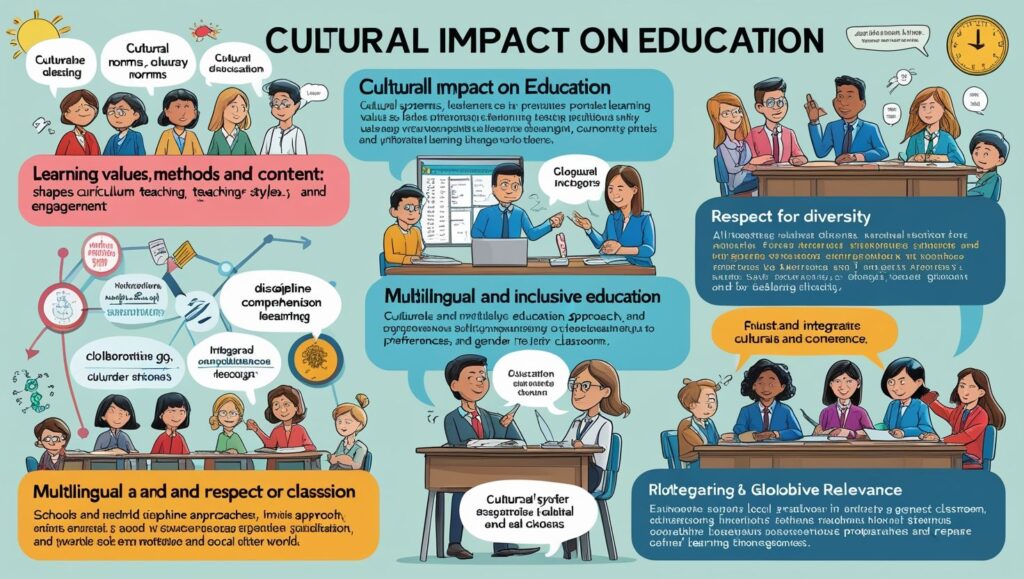Introduction:
Cultural Impact on Education is a powerful force that shapes the way we perceive the world, interact with others, and approach learning. The intricate interplay between culture and education is a dynamic and multifaceted relationship that significantly influences the teaching and learning process. This article delves into the profound cultural impact on education, exploring how diverse cultural backgrounds enrich the learning experience, foster inclusivity, and prepare students for a globalized world.
Cultural Context in Curriculum Design:
The cultural context plays a pivotal role in shaping curriculum design. A curriculum that reflects the cultural diversity of its students not only validates their identities but also ensures that the learning materials resonate with their lived experiences. Inclusive curriculum design acknowledges and celebrates the richness of various cultures, providing students with a more comprehensive and relatable educational experience.
Language and Communication Styles:
Language is deeply intertwined with culture, and the way individuals communicate is often shaped by their cultural backgrounds. In an educational setting, recognizing and respecting diverse language and communication styles is essential. Embracing linguistic diversity enhances students’ ability to express themselves, fosters effective communication, and bridges cultural gaps within the learning environment.

Cultural Competence in Teaching:
Cultural competence is a crucial skill for educators in a diverse classroom. Understanding the cultural nuances of students allows teachers to create an inclusive and supportive learning environment. Educators who are culturally competent can adapt their teaching strategies, incorporate diverse perspectives, and leverage culturally relevant examples, making the educational experience more meaningful and accessible to all students.
Global Awareness and Citizenship:
Education is not just about acquiring knowledge; it is also about preparing students to be global citizens. Exposure to diverse cultures in the educational curriculum cultivates global awareness and promotes a sense of global citizenship. This, in turn, nurtures empathy, understanding, and respect for different cultures, essential qualities in an interconnected and globalized world.
Cultural Impact on Learning Styles:
Cultural backgrounds influence individual learning styles. Some cultures may value collaborative learning, while others may prioritize independent study. Recognizing and accommodating diverse learning styles ensures that educational strategies resonate with students, maximizing their engagement and comprehension. Tailoring teaching methods to align with varied learning styles fosters a more inclusive and effective educational experience.

Addressing Stereotypes and Bias:
Cultural impact on education also involves addressing stereotypes and biases that may exist within educational materials and practices. By promoting culturally responsive teaching, educators can challenge stereotypes, eliminate bias, and create a learning environment that is free from discriminatory attitudes. This proactive approach contributes to the development of a more equitable educational system.
Cultural Identity and Student Well-Being:
Acknowledging and affirming students’ cultural identities positively impacts their overall well-being. When students see their cultures respected and incorporated into the educational experience, it contributes to a sense of belonging and self-worth. This, in turn, has a positive effect on motivation, engagement, and mental health, fostering a conducive atmosphere for effective learning.
Cultural Exchange and International Education:
Cultural impact extends beyond the borders of individual classrooms. International education programs and cultural exchanges offer students the opportunity to engage with diverse perspectives firsthand. Experiencing different cultures firsthand fosters open-mindedness, tolerance, and a global perspective, preparing students for an interconnected world.
Parental and Community Involvement:
Education is a collaborative effort that extends beyond the classroom. Involving parents and the community in the educational process ensures that cultural values are reinforced both at home and in school. Building partnerships with families from diverse cultural backgrounds creates a more supportive and holistic educational environment.
Preparing Students for a Diverse Workplace:
As students progress through their educational journey, the cultural impact on education becomes instrumental in preparing them for the workforce. In an era of globalization, workplaces are increasingly diverse. A culturally responsive education equips students with the skills needed to navigate and thrive in diverse professional environments.
Conclusion:
In conclusion, the cultural impact on education is profound and far-reaching. Embracing cultural diversity in education not only enhances the learning experience but also equips students with the skills and perspectives needed to thrive in an interconnected and diverse world. By recognizing the influence of culture on curriculum, teaching methods, communication styles, and more, educators can create inclusive and culturally responsive learning environments that foster a love for learning and prepare students to be thoughtful, empathetic, and globally aware citizens.

Can you be more specific about the content of your article? After reading it, I still have some doubts. Hope you can help me.
Your point of view caught my eye and was very interesting. Thanks. I have a question for you.
Your article helped me a lot, is there any more related content? Thanks!
35vjbj
Howdy! Someone in my Facebook group shared this website with us so I came to look it over. I’m definitely loving the information. I’m book-marking and will be tweeting this to my followers! Outstanding blog and great style and design.
Your article helped me a lot, is there any more related content? Thanks!
8eww7o
Your article helped me a lot, is there any more related content? Thanks!
We are a group of volunteers and starting a new scheme in our community. Your web site provided us with valuable info to work on. You have done a formidable job and our entire community will be grateful to you.
I don’t think the title of your article matches the content lol. Just kidding, mainly because I had some doubts after reading the article.
Exactly what I was looking for, regards for posting.
You have noted very interesting points! ps decent internet site.
Well I sincerely enjoyed studying it. This tip offered by you is very useful for accurate planning.
I really like your writing style, wonderful information, thank you for posting :D. “I will show you fear in a handful of dust.” by T. S. Eliot.
https://t.me/s/TgGo1WIN/15
https://t.me/s/Official_1win_kanal/1544
https://t.me/s/Webs_1WIN
Официальный Telegram канал 1win Casinо. Казинo и ставки от 1вин. Фриспины, актуальное зеркало официального сайта 1 win. Регистрируйся в ван вин, соверши вход в один вин, получай бонус используя промокод и начните играть на реальные деньги.
https://t.me/s/Official_1win_kanal/4411
Официальный Telegram канал 1win Casinо. Казинo и ставки от 1вин. Фриспины, актуальное зеркало официального сайта 1 win. Регистрируйся в ван вин, соверши вход в один вин, получай бонус используя промокод и начните играть на реальные деньги.
https://t.me/s/Official_1win_kanal/611
Good day! I know this is somewhat off topic but I was wondering which blog platform are you using for this website? I’m getting fed up of WordPress because I’ve had problems with hackers and I’m looking at alternatives for another platform. I would be awesome if you could point me in the direction of a good platform.
I think this is among the most significant information for me. And i am happy reading your article. However want to observation on some normal things, The site taste is perfect, the articles is in point of fact nice : D. Good job, cheers
You have brought up a very great points, appreciate it for the post.
Great information. Lucky me I recently fouhd your site by chance (stumbleupon).
I have book-marked it for later! https://glassi-greyhounds.mystrikingly.com/
Thanks for sharing. I read many of your blog posts, cool, your blog is very good. https://www.binance.info/uk-UA/register-person?ref=W0BCQMF1
Thank you for your sharing. I am worried that I lack creative ideas. It is your article that makes me full of hope. Thank you. But, I have a question, can you help me?
Thank you for your sharing. I am worried that I lack creative ideas. It is your article that makes me full of hope. Thank you. But, I have a question, can you help me?
But wanna remark that you have a very nice site, I enjoy the layout it really stands out.
You have noted very interesting details! ps decent site. “Ask me no questions, and I’ll tell you no fibs.” by Oliver Goldsmith.
This is really interesting, You are a very skilled blogger. I’ve joined your rss feed and look forward to seeking more of your great post. Also, I have shared your site in my social networks!